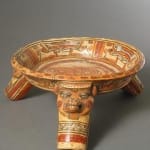Terracotta Polychrome Tripod Bowl, 1000 CE - 1550 CE
Terracotta
13.25 x 5.5
PF.3776
Further images
Brilliant hues of a glorious sunset are splashed upon this fascinating bowl. With a palette of gold, the ancient artist appears to have applied innumerable references of animals. Along the...
Brilliant hues of a glorious sunset are splashed upon this fascinating bowl. With a palette of gold, the ancient artist appears to have applied innumerable references of animals. Along the edge, deep burnished red spots reminiscent of a leopard's spots are painted in groupings of five. Large crocodile snout masks protrude forth form the human faces on the rattle-tripod legs. Their long snouts reveal grimacing sharp teeth. Peculiar ears are set high above the wide eyes with thick, bushy eyebrows. The ears may refer to the jaguar, thus creating a mythological zoomorphic creature that comprises both crocodile and jaguar characteristics. Beneath the heads are rows of teeth set with a light blue background. Blue pigment is very seldom seen on polychrome ceramics and is regarded as being very rare and unique. The entire bowl on the inner and outer rims is magically covered with designs, which most probably had precise meanings to the Ancient Costa Ricans. We have yet to decipher these curious designs. Centrally located on the bottom surface of the bowl is an ornate figure with a deep burnished red circle surrounding it? As we turn the bowl upside-down, we can see a large circle, which may symbolize the almighty sun, giver of life and light. We can only imagine what this bowl once held and who held and used it in return. We are certain that elaborate bowls with rattle-tripod legs were ritual objects, most likely used by a shaman or important leaders of society. The magic and mysterious beauty of this ancient artifact lures us into a once flourishing culture that has startled humanity with its energetic and ingenious art.





